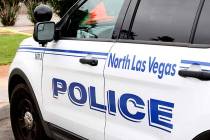Poor roads cost Nevadans $2.1 billion a year, report says
More than half of the state and locally maintained roads in Nevada are in poor or mediocre shape, according to a new report from a Washington, D.C., based research group.
The report, released Thursday, estimates that the low-quality roads cost Nevada residents $2.1 billion a year in added vehicle operating costs, lost time and wasted fuel because of congestion and traffic.
The authors, from TRIP, a nonprofit transportation research group, estimate the cost to an average resident of the Las Vegas area is $1,464 a year.
The report, titled “Nevada Transportation by the Numbers: Meeting the State’s Need for Safe and Efficient Mobility,” comes as state lawmakers are considering two bills that could raise fuel taxes in Nevada.
Senate Bill 377 is being considered by the Senate Revenue and Economic Development Committee. It would increase the state tax on gas from 17.65 cents per gallon to 19.65 cents starting next year. The tax would rise 2 cents a year until 2023.
Assembly Bill 413 would allow Clark County to raise the local gas tax. Clark is the only county in the state that does not have such authority.
Frank Moretti, director of research and policy for TRIP, said the problem of inadequate and crumbling roads is not limited to Nevada.
“State governments are really coming out of a period of denial,” he said.
For too long, he said, many states depended on federal funding for roads.
“That really hasn’t happened,” he said. “Federal transportation dollars have remained essentially even for the last seven or eight years.”
The TRIP report estimates that 51 percent of the state and locally maintained roads in Nevada are in poor or mediocre shape. That figure climbs to 56 percent for the Las Vegas area and a whopping 86 percent for the Reno-Carson City area.
More than half of the estimated cost to drivers is because of congestion, the report said. A study from the Texas Transportation Institute estimated that the average Las Vegas-area commuter spends 44 hours a year stuck in traffic.
The TRIP report also said that vehicle miles traveled in Nevada jumped
137 percent between 1990 and 2011, from 10.2 billion miles traveled to 24.2 billion. That is the largest increase of any state.
The report comes on the heels of last month’s study by UNLV’s Center for Business and Economic Research. That study said the deficit in the Nevada State Highway Fund is expected to increase from $136 million to $220 million by 2020 if no new highway revenue is raised.
The State Highway Fund, which pays to build new roads and maintain current ones, gets revenue from the license and registration fees and gas taxes, as well as the federal government.
The UNLV study said that today’s cars and trucks get better gas mileage than they did in years past. Today more miles are traveled in Nevada and fewer gallons of gasoline are sold. Because gas taxes are charged per gallon at a flat amount not indexed to inflation, revenue is not keeping up with demand.
As the state’s population grows and vehicles become even more efficient, the problem of how to pay for Nevada’s highways will get worse.
“Closing the funding gap with motor fuel taxes will require about a 2.8-fold increase of the Nevada tax rate on motor vehicle fuels by 2030,” the study said.
Other possible solutions, according to the study, include adopting a tax that is based on miles driven instead of gallons used or increasing registration fees.
Nevada’s highways
■ $2.1 billion, the annual cost to Nevadans because of congestion, poor roads and a lack of safety features
■ $1,464, the annual cost to Las Vegas area resident because of congestion, poor roads and a lack of safety features
■ 51 percent, the portion of Nevada’s state and locally maintained roads that are in poor or mediocre condition
■ 137 percent, the increase from 1990 to 2011 in the number of miles driven in Nevada, the largest increase of any state
Source: "Nevada Transportation by the Numbers: Meeting the State’s Need for Safe and Efficient Mobility," from TRIP, a nonprofit transportation research organization

















